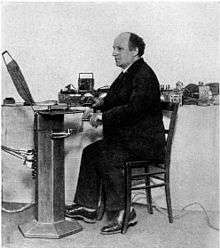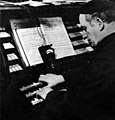Jörg Mager
Jörg Georg Adam Mager (6 November 1880 - 5 April 1939) was a German musician and inventor, who was a pioneer of early electronic music.
Jörg Mager | |
|---|---|
 Jörg Mager playing on Spherophone at the 1926 summer music festival in the Black Forest town of Donaueschingen | |
| Background information | |
| Born | 6 November 1880 Eichstätt, Bavaria |
| Died | 5 April 1939 Aschaffenburg, Bavaria |
| Genres | Electronic |
| Occupation(s) | Musician and inventor |
Mager was born in Eichstätt in Bavaria, in 1880. An idealist by nature, he worked as a schoolteacher and organist to fund his research into electronic instruments. In 1911, after hearing an organ that had become slightly detuned due to temperature variations, Mager began researching quarter tones, and built a harmonium based on quarter-tonal divisions. This became the basis for many of his later instruments.[1]
In the 1920s, Mager developed the Electrophon (later renamed to the Spharophon), a keyboard instrument that produced sound using heterodyning. Its premiere at the 1926 Donaueschingen Festival was well received by the attendees, including Paul Hindemith and Alois Hába. In the late 1920s Mager received a government grant, and used this money to found a laboratory near Darmstadt; he also began an Electronic Music Society at around the same time.[2] At his laboratory Mager designed and constructed an organ which he used alongside a huge array of amplifiers, aluminium pots, glass plates, oven pipes and the wooden frame of a cello which used a frying pan as an additional amplifier. All of these were linked to the organ by wires to produce the 'tonal colours' Mager experimented with.[3]
Mager was among the first musicians to begin serious discussion of electronic music, with his 1924 essay Eine neue Epoche der Musik durch Radio ("A New Epoch in Music through Radio").[4]
Although he created a number of unique electronic instruments, including the Kurbelspharophon and the Kaleidophon, all of his examples were destroyed by Allied bombing raids during World War II.[5]
Gallery
 Laboratory of Jorg Mager, c. 1938, photographer unknown, PIX Magazine[6]
Laboratory of Jorg Mager, c. 1938, photographer unknown, PIX Magazine[6] Jorg Mager working on his organ, c. 1938, photographer unknown, PIX Magazine[7]
Jorg Mager working on his organ, c. 1938, photographer unknown, PIX Magazine[7] Jorg Mager playing his organ, c. 1938, photographer unknown, PIX Magazine[8]
Jorg Mager playing his organ, c. 1938, photographer unknown, PIX Magazine[8] Jorg Mager playing the Gral Bells, c. 1938, photographer unknown, PIX Magazine[9]
Jorg Mager playing the Gral Bells, c. 1938, photographer unknown, PIX Magazine[9]
References
- Albert Glinsky (2000). Theremin: Ether Music and Espionage. University of Illinois Press. p. 53. ISBN 978-0-252-02582-2.
- Carmelo Peter Comberiati; Matthew C. Steel; Gwynn S. McPeek (January 1988). Music from the Middle Ages Through the Twentieth Century: Essays in Honor of Gwynn S. McPeek. Taylor & Francis. pp. 244–245. ISBN 978-2-88124-216-8.
- PIX Magazine, Vol. 3 No. 2 (14 January 1939)
- M. J. Grant (8 June 2005). Serial Music, Serial Aesthetics: Compositional Theory in Post-War Europe. Cambridge University Press. p. 51. ISBN 978-0-521-61992-9.
- Nicole V. Gagné (2012). Historical Dictionary of Modern and Contemporary Classical Music. Scarecrow Press. p. 166. ISBN 978-0-8108-6765-9.
- Vol. 3 No. 2 (14 January 1939)
- Vol. 3 No. 2 (14 January 1939)
- Vol. 3 No. 2 (14 January 1939)
- Vol. 3 No. 2 (14 January 1939)
External link
![]()